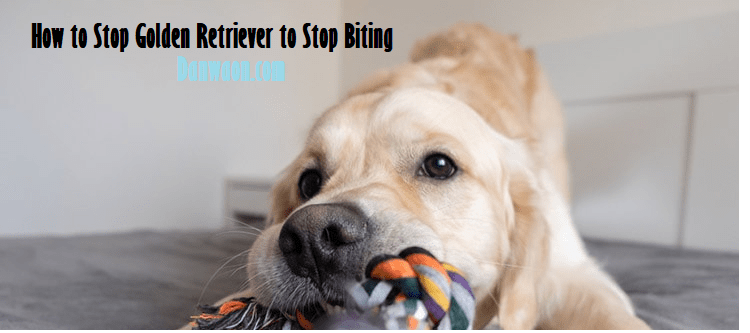How To Take Care And Brush Your Golden Retrievers Teeth
The Golden Retrievers teeth played an important role in the era when it was active as a hunting dog. In order to collect prey without damaging it, they were required to have a “soft mouse”. Even if they can chew things softly, they still have the strength to chew because of their large bodies, so you need to be careful not only of dental diseases but also of broken teeth.
Golden Retriever teething age
Like humans, there is a period of bruxism. Golden Retriever puppy teeth begin to grow at one month of age. In about 2 months, all the baby teeth will grow, and golden retriever puppy teeth fall out between the age of 3 and 7 months. Don’t panic if your dog’s teeth are missing.
Dogs have 28 baby teeth 42 permanent teeth will grow. Puppies stimulate their teeth when they are young. If you look at a person’s hands and feet, they will bite you. If you just leave it alone even when they grow up, puppies have a habit of biting people’s hands and feet. You need to train well during this period. It would be better to not bite when the puppies are teething
Golden Retriever teeth problems
Tartarus
The most famous problem when we talk about Golden Retriever’s teeth is undoubtedly Tartarus, sometimes called calculus
Dental calculus not only harms the health of teeth and gums but is also an aesthetic problem, since, being porous, it absorbs stains more easily. If not treated and disposed of correctly, plaque and tartar can cause various diseases and problems with teeth and gums.
Symptoms
One of the first symptoms of tartar is bad breath, the main complaint of Golden Retriever owners. Many times we do not notice a difference in the color and appearance of the teeth, but we feel the bad breath of the Golden Retriever indicating that the tartar is accumulating.
Teeth affected by tartar turn yellow and turn brown, and the tartar begins to push the gum, leaving it red, inflamed, and in more serious cases, corroding the gum tissue. If not treated and disposed of correctly, plaque and tartar can cause various diseases and problems with teeth and gums.

How to take care of Golden Retrievers teeth
It is very important to take care of your Golden Retriever’s teeth regularly, as toothaches can cause eating problems and can become grumpy. So how do brush the teeth of the Golden Retriever and take care of the dental health of the golden retriever?
Regular cleaning and grinding
Wash and polish the golden retriever’s teeth regularly as the first step of care. Because Golden Retriever teeth cleaning can remove plaque and tartar on the teeth. Grinding teeth can make it difficult for plaque to deposit. Regular scaling and grinding have exceptional effects on dental health.
Dental care plan
A veterinarian can check for plaque and tartar in your Golden Retriever’s mouth. A special stain is used during the examination to make the sign more visible. Your veterinarian will come up with a care plan for your Golden Retriever’s dental care.
Cultivate the habit of brushing your teeth
Like us humans, brushing teeth is also an important step to protect the dental health of golden retrievers. The owner can use toothpaste and toothbrushes specially designed for pets to brush their teeth, which will not only protect the dental health of golden retrievers but also increase the affinity between you.
Eat a balanced diet
The diet of the Golden Retriever should be balanced, especially to provide enough calcium and phosphorus for toothbrushes. When you find that the Golden Retriever has dental problems, you can appropriately increase the calcium in the food.
Food type screening
It’s best not to feed your Golden Retriever bones, which can damage their teeth, causing cracks and pain. If you use canned food, you should add some biscuits and other coarse grains rich in plant fiber.

How to brush Golden Retriever teeth
Here is a step-by-step guide to brushing your Golden Retrievers teeth
- Casually touch your dog’s mouth with your finger or hand when giving treats or stroking the body to get used to being touched around the mouth.
- Once you get used to it, try things like “just put your finger in your mouth,” “turn your lips over,” and “touch your gums.”
- Next, moisten your finger with gauze and rub it gently on the teeth.
- Start with the incisors (front teeth).
- As you get used to it, it will gradually move to the back teeth.
- Once you get used to finger gauze, you can switch to a toothbrush.
- At first, praise him for letting him smell the toothbrush, letting him play, and putting the toothbrush in his mouth, even if only for a moment.
- Start with the incisors and gradually work the canines and back teeth.
- It’s ok to just the outside of your teeth at first.
- Finally, you will be able to brush the back side of your teeth as well.
- By getting used to it little by little, you can brush your Golden Retrievers teeth with less stress.
Here are some reasons why Golden Retrievers hate brushing their teeth:
Here are some reasons why Golden Retrievers hate brushing their teeth:
- He’s not used to having my mouth touched
- It hurts because the brushing method is too strong
- Toothbrush too hard or too big
- There is discomfort and pain due to problems in the teeth and mouth
- He hates being forced
- He is usually scolded for having my muzzle caught
Golden Retriever tooth replacement period
The thing that every dog will experience is tooth replacement. Pets should pay attention to the precautions during the tooth replacement period of golden retriever dogs. Otherwise, the Golden Retriever’s teeth may not fall out because of the old teeth, which will cause the position of the new teeth to be incorrect, and the teeth that grow out will not look good.
When do Golden Retrievers teeth fall out
Golden Retrievers generally change their teeth when they are 4-6 months old. In the beginning, they will replace the six incisors in the middle of the canine teeth in their mouths. At 5-6 months, all the remaining Golden Retriever’s teeth will be replaced with adult teeth. Because the teeth and gums will feel unbearably itchy during the teething period, it is normal for dogs to be restless.
What should I pay attention to?
Teething toys
Prepare teething toys in advance, such as teething sticks, dog chews, or teething snacks to divert the dog’s attention, and at the same time make the dog less bored. Avoid shoes, cabinets, and chairs at home.
Pain Relief Tools
During the tooth replacement period, the golden retriever’s teeth will feel itchy and unbearable. The owner can take a towel and freeze it to soak it, put it in the refrigerator, and let the dog bite it, which can have the effect of labor pain, but this is only in summer.

The position of the new teeth is not correct
When a golden retriever is changing its teeth, it is generally impossible to find the replaced baby teeth. It is very likely that the dog will eat them as food, or take them to play with. The owner does not need to worry, this will not harm the dog’s body. Pay attention to whether the old teeth are replaced smoothly after the new teeth grow out, so as to avoid the problem of misalignment of the new teeth
No sweets
Not only dogs in the teething period but also dogs with high-sugar sweets, such as cakes and fudge, are not allowed to be fed to dogs at ordinary times, as they are prone to tooth decay and the teeth are easily broken. So don’t wait until the teeth are broken before thinking about taking care of the dog!
Take calcium supplements
Golden Retrievers can take the proper amounts of calcium supplements during the period of tooth change. It is also okay to feed the dog some calcium tablets or chew on big bones. Proper calcium supplementation can make the Golden Retrievers teeth harder and bones stronger. But remember, don’t overdo it with calcium.
How to train during the tooth change period?
Golden Retrievers will bite things and grind their teeth indiscriminately during the tooth change period. The owner should not let go of the dog training work during this period. It is still necessary to carry out moderate education work on the dog and not let its troublesome behavior be allowed.
Put things away
Golden Retrievers are very curious. The owner should put away the things that are easy to be bitten at home, such as disinfectant, laundry detergent, power cords at home, etc., and close the door where they cannot enter to avoid danger.
There are rewards and punishments
When training golden retriever puppies, remember to prohibit when it is forbidden, and reward when it is time to reward. This is easy to train for puppies with a relatively high degree of acceptance.
Timely block
When you see a dog knocking something that cannot be knocked, you should stop it immediately and take it away, and then say no to the dog.
Appropriate encouragement
There are punishments and there are rewards. If the golden retriever puppy obeys the owner’s instructions in time and stops biting, and can play with his toys obediently, the owner can give a compliment or a snack as a reward to encourage the dog.
Can you tell how old a golden retriever puppy is by looking at its teeth?
From the analysis of the picture, about 1/2 of the deciduous teeth have erupted, so it can basically be considered that the dog should be about 20 days old or nearly one month old, or just one month old. medium-sized dogs usually begin to grow one week to 10 days after birth Baby teeth come out.
But for example, some medium-sized dogs of different breeds grow fast and some grow slowly. Even the same breed also has fast teeth and slow teeth. Dogs born in the same litter are all quite different. There are black and white teeth in the same litter. These are hard to say, just refer to the above content in general.

What are the oral diseases of golden retrievers?
Golden Retrievers are prone to oral diseases very much If your golden retriever’s teeth are not clean and remain dirty for a long time then she might also have these diseases that we discuss below it is very important for you to learn about the oral diseases related to the Golden Retriever
Calculus:
Once dental calculus forms on a dog’s teeth, it is difficult to remove. Therefore, the owner should help the dog clean its teeth regularly, and even take it to the veterinarian to wash its teeth if necessary.
Gingivitis:
Because dogs do not know how to clean their teeth, after countless meals, their gums will accumulate a lot of food residue, causing a large number of bacteria to grow here. When bacteria invade the gums, they can inflame the gums and cause pain and they prone to this problem
Periodontal disease:
Periodontal disease can cause gum swelling, inflammation, and bleeding, severely damage the gum tissue, cause the teeth to shake greatly, and eventually lead to a large number of tooth loss. Therefore, periodontal disease is a very serious dental disease. If you find that your dog has periodontal disease, you should immediately take it to the veterinarian for treatment.
Tooth decay:
In addition to humans, dogs can also suffer from tooth decay. Tooth decay is the gradual dissolution of calcium in the teeth to form caries. It can cause gum pain, tooth necrosis, and loss of appetite in dogs.
Malocclusion:
There are two main reasons for this: one is that the upper and lower jaws of the dog have problems during development, resulting in the inability to open and close normally. The second is that when the permanent teeth erupt, they are held by the temporary teeth, resulting in ectopic growth. In dogs with malocclusion, the teeth will get stuck when closing the mouth, which will affect eating.
Broken teeth:
Dogs are born to chew on objects, and sometimes they even chew on rocks, which wears down or even breaks their teeth. Some more active dogs are more likely to run around and break their teeth. In addition, dogs can also develop this problem when they are old.
Tongue abscess:
If the sublingual salivary glands become blocked, a large, fluid-filled bump can develop on the underside of the tongue. This is a sublingual abscess. If the owner finds that the pet dog has this problem, he should straight away find a veterinarian for surgery to load the fluid. The cause of the blockage could also be a stone or even a grass seed.
Conclusion
Our article about Golden Retriever teeth is just a guide to show you the best way of taking care of your golden retriever’s teeth. Golden Retriever is a very intelligent dog breed if you train your Golden Retriever during the teeth development period then it would prove to be your best partner in the future. In case you miss any information about Golden Retriever or you want to learn more interesting facts about Golden Retriever then I suggest you visit my website by typing www.Danwaon.com. Golden Retriever is known for his non-aggressive and family-friendly nature.




